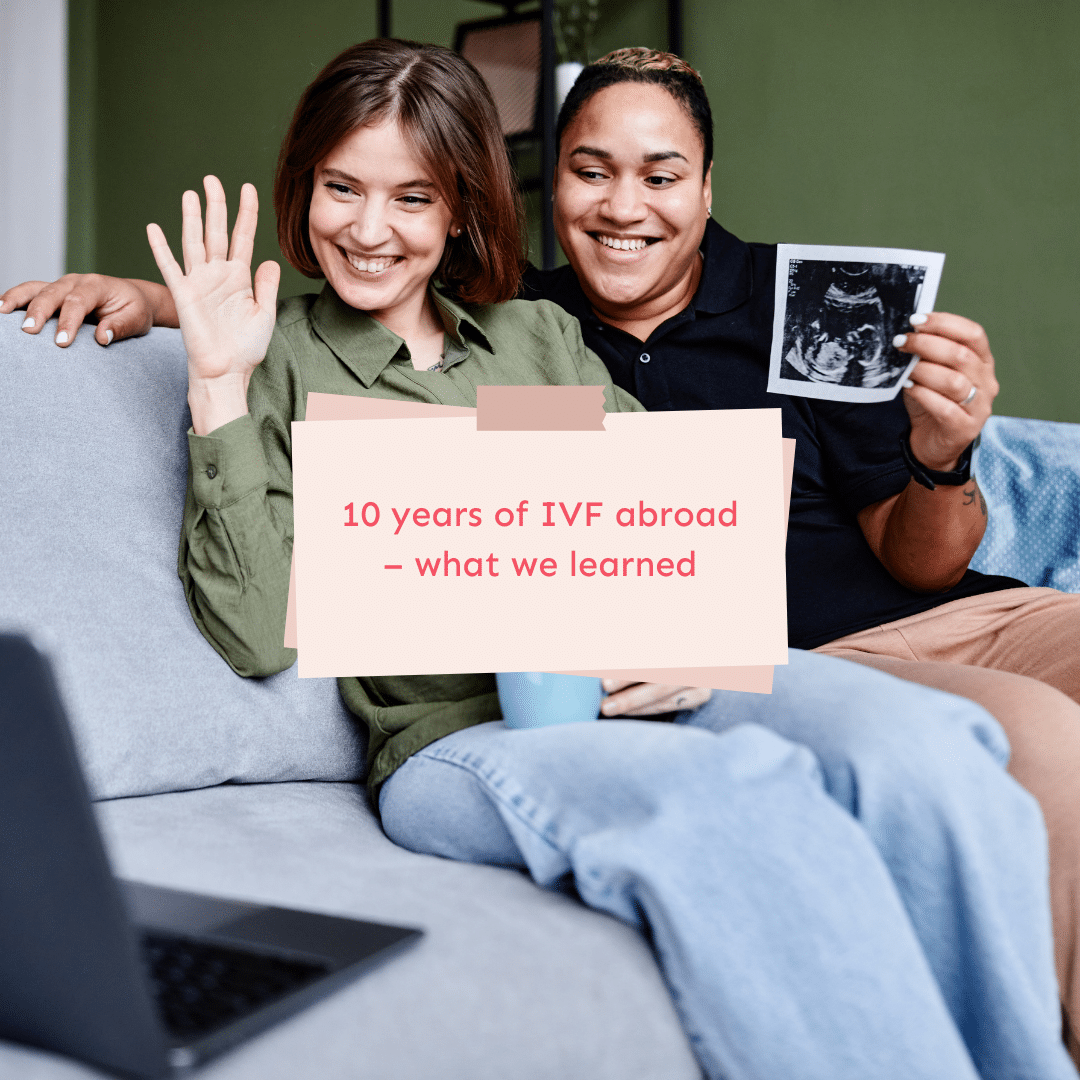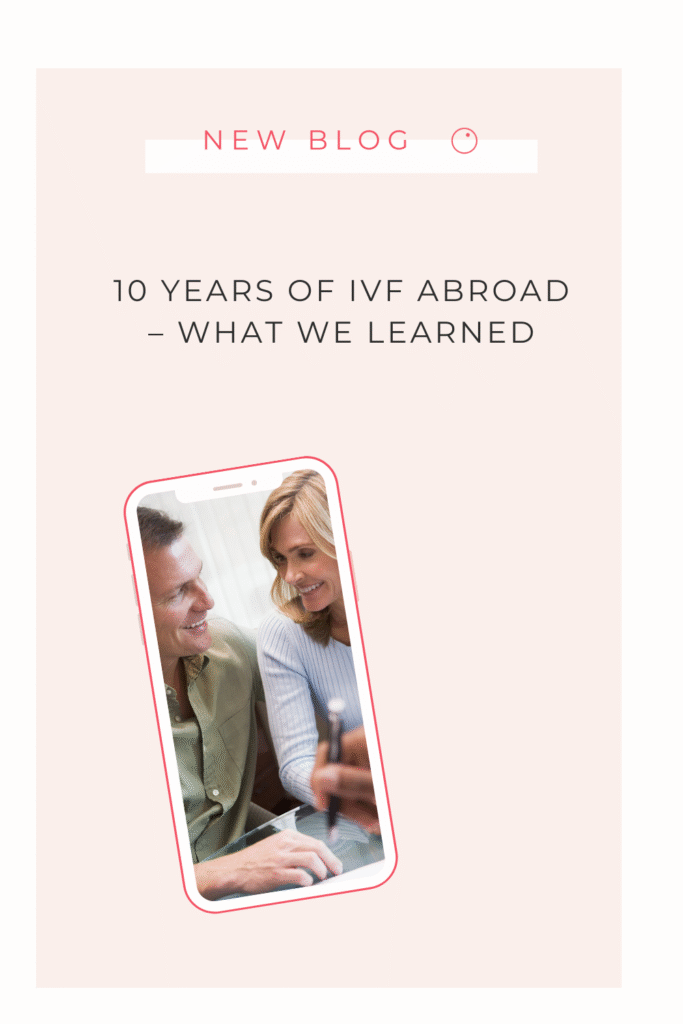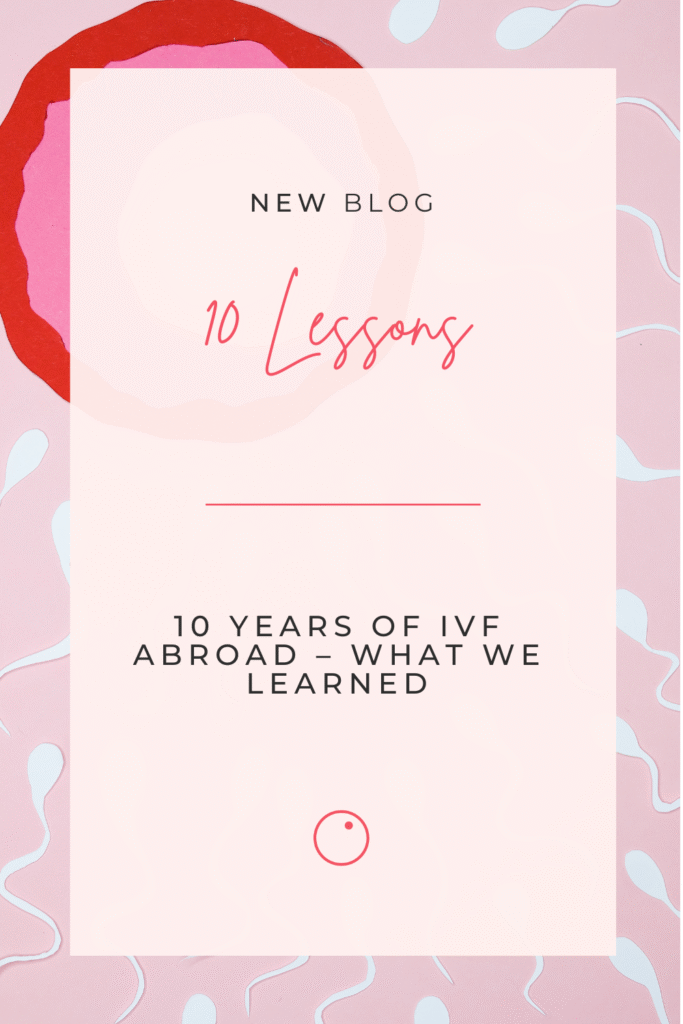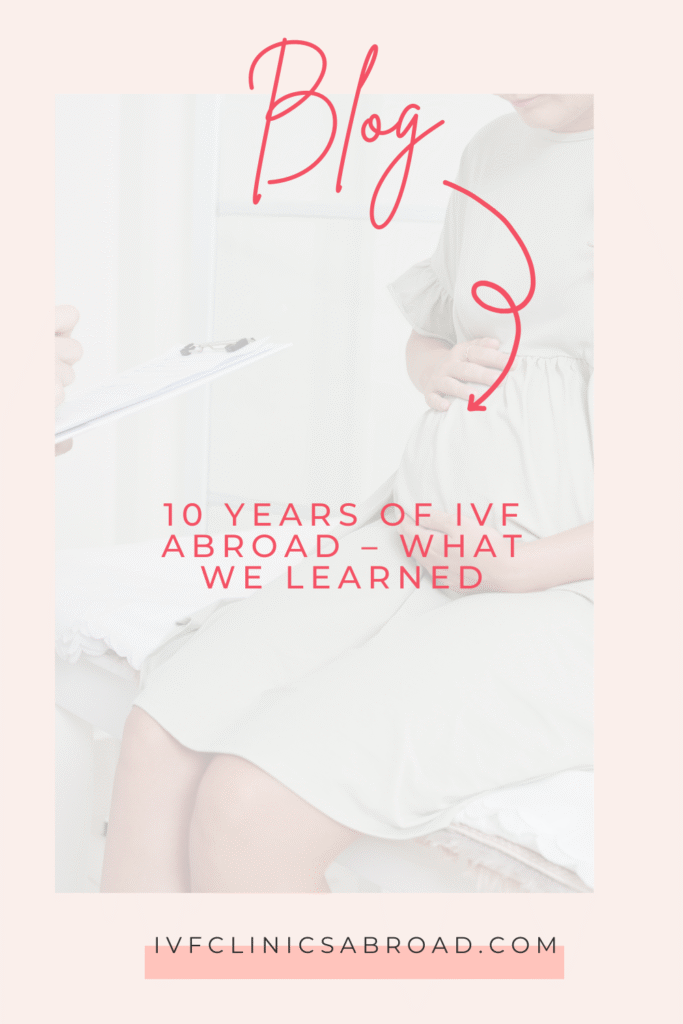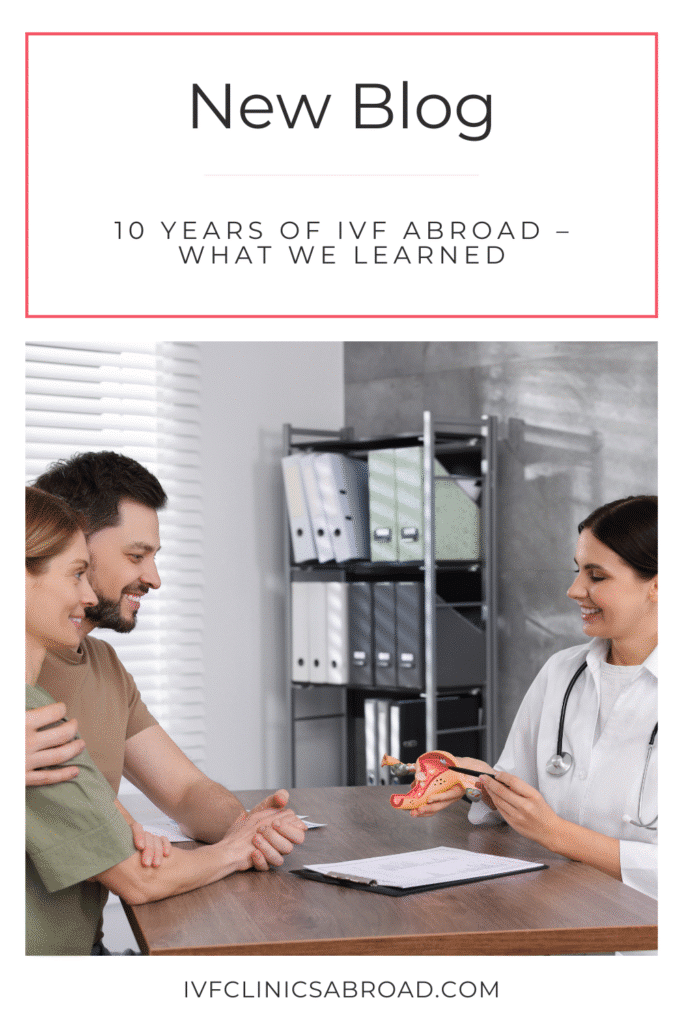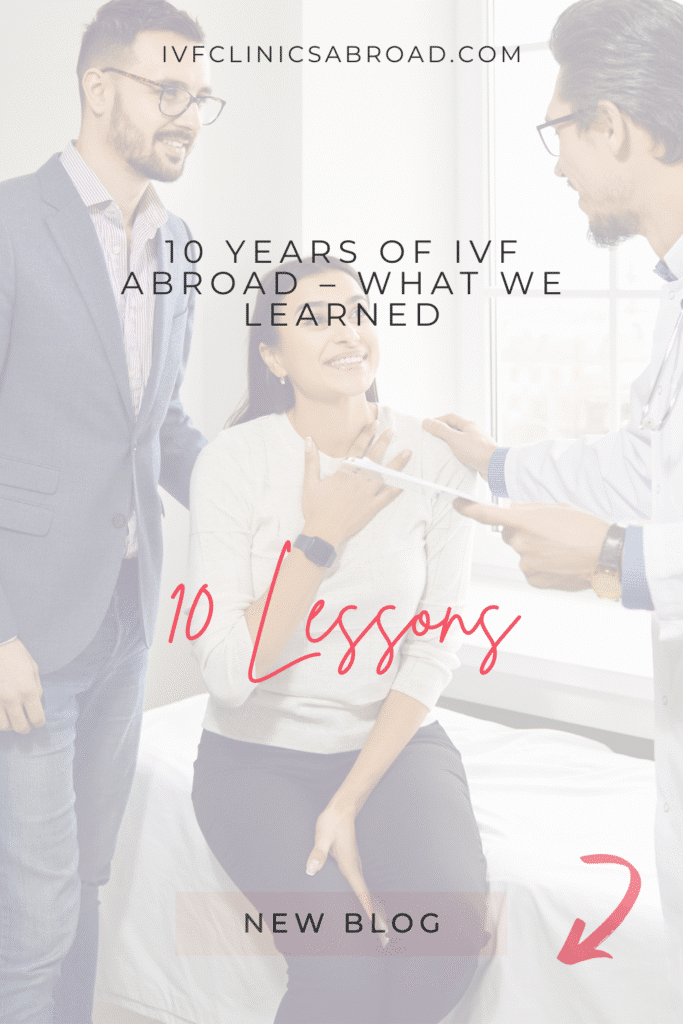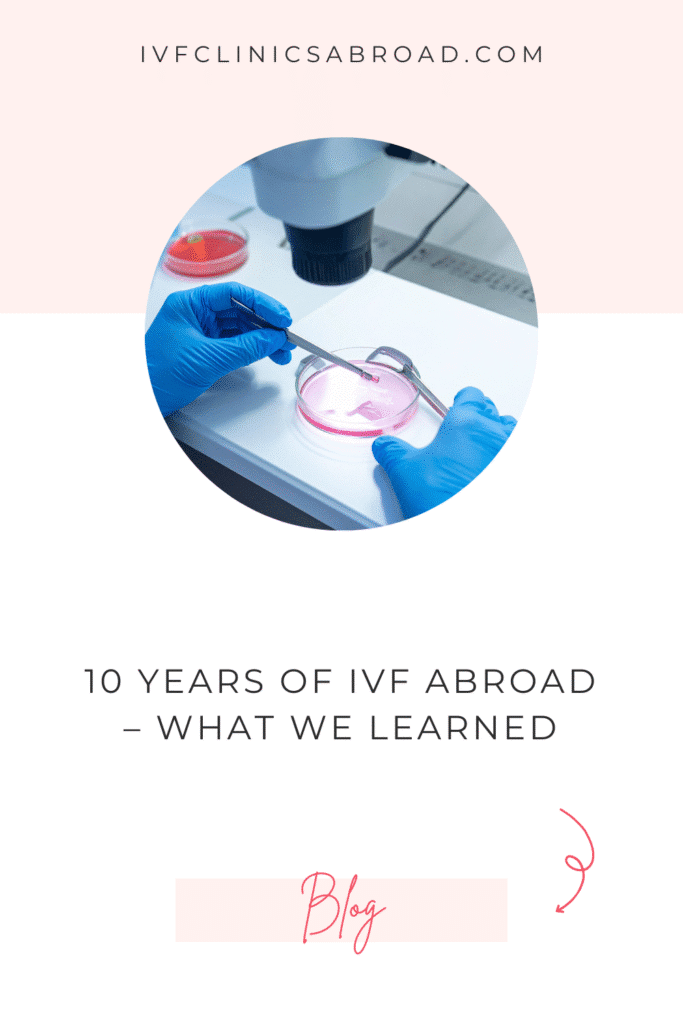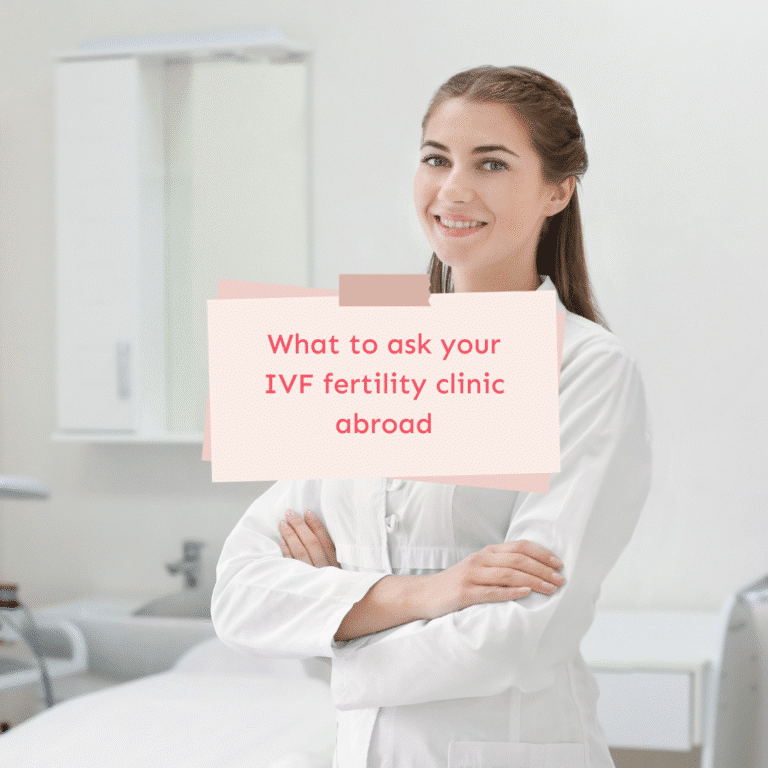10 years of IVF clinics abroad – lessons learned about fertility, donor eggs and assisted reproductive technology
When I founded Swiss Medical Travel on 4 November 2015, my goal was simple – to help Swiss women find affordable medical treatments abroad. Back then it was about many different areas, but it quickly became clear that my passion and my experience belonged with IVF treatment. I had gone through infertility myself, faced miscarriages, and discovered that in many countries abroad I received more support than in my home country.
Because I had worked as a tour guide, I was curious wherever I went. In every new country I visited, I would ask about clinics, prices, and how reproductive medicine was organised. Over the years I walked through the doors of more than a hundred clinics – and I even wrote my master’s thesis on medical tourism.
I want this anniversary blog to be an honest reflection of what I have seen and learned. Ten years later I look back on a long journey through assisted reproduction in Europe. I learned that IVF abroad can feel intimidating because of fears around quality, aftercare and language. I realised that Spain is not the only option, and that laws, prices and access to fertility treatment differ widely across countries. I discovered how commission models influence advice, and why I decided to work independently. I saw how natural conception coaches with thousands of followers attract attention more easily than fertility clinics, while IVF requires transparency and trust. I understood how online platforms and rankings are often more about visibility than independence. I experienced how supporting egg donation or embryo donation meant exclusion from medical associations, even though many infertility patients rely on these treatments. I watched as big clinic chains expanded, while family-run centres with stable teams often offered more personal support. I learned how forums and social media groups can confuse more than they help, because one infertility story can never speak for all. I heard countless women share how hard it is to talk about taboo topics like gender selection, single motherhood or age-related fertility. And finally, I saw how missing standards, hidden costs and lack of aftercare remain a challenge in many clinics abroad.
These are the lessons learned from ten years of IVF clinics abroad. These lessons highlight how much has changed in human reproduction and assisted reproductive technology – but also how much work still lies ahead.
1. Medical tourism and why IVF abroad is still under suspicion
When people hear the term medical tourism, they often think of low prices and questionable quality. IVF abroad is no exception. Even though assisted reproduction has become a well-established field of reproductive medicine, many women still feel uncertain when they consider leaving their home country for fertility treatment. The idea of travelling abroad for IVF sounds risky, as if stepping outside national borders automatically means less safety.
Fear of lower quality, lack of aftercare and language barriers
The most common worries are always the same. Women are afraid that clinics abroad may not meet the same standards, that they will be left alone without proper aftercare, or that communication will fail because of language barriers. These fears are understandable. Infertility already creates enough stress, and the thought of navigating another healthcare system can feel overwhelming. What I have learned is that the quality of IVF treatment varies everywhere – both in your own country and abroad.
How infertility and trust issues shape decisions about clinics abroad
Trust is at the heart of every IVF journey. Infertility patients want to feel safe and understood, and they need clear information before making a decision. The challenge with clinics abroad is that transparency is not always given. Success rates can be presented in different ways, prices are not always visible online, and sometimes medical staff change frequently. All of this makes it difficult for women to compare options. Many still believe that staying at home automatically offers better care, but that is not always true. The real difference lies in how open a fertility centre is about its methods, costs and support. For patients considering IVF abroad, asking the right questions and demanding clear answers is the only way to replace fear with confidence.
2. There is more than Spain in IVF clinics abroad
When people think about IVF abroad, the first country that comes to mind is almost always Spain. It is true that Spain has a long history with assisted reproduction and many fertility clinics with international marketing experience. But focusing only on one destination hides the reality that Europe is a patchwork of different laws, standards and options. Women often hear about Spain through word of mouth, while other countries remain invisible – even though they may offer very different prices or legal options.
How laws and access to assisted reproduction differ across Europe
Every country has its own legal framework, and this is what makes the search so complex. In some places egg donation is anonymous, in others only open donation is allowed. Some countries permit treatment for single women and lesbian couples, while others still restrict access to fertility services. Assisted reproduction may be legal in one country but not in the next. This means that women who travel abroad for IVF must navigate very different systems, often without clear guidance. What feels safe and accepted in one country could be considered illegal or even punishable in another. This confusion is one of the biggest challenges in the IVF journey.
Prices, quality and why not all fertility clinics are ideal for IVF treatment
Price is another factor that often misleads women. The first impression is that IVF abroad is simply cheaper, but lower costs do not always mean the same level of support or laboratory standards. Some fertility centres publish transparent price lists, while others hide essential extras such as medication, cryopreservation or genetic testing. The same is true for quality. Not every clinic abroad is ideal for IVF treatment, and success depends on details like embryology expertise, the number of embryos transferred, and how aftercare is organised. This is why it is so important to compare at least two or three clinics abroad, request full treatment plans, and check how each centre communicates before making a final choice.
3. Commission models and independence in IVF advice
One of the first things women notice when they start looking at clinics abroad is how many agencies and middlemen appear. Most of them work on a commission model. The clinic pays them a percentage, and in return they bring in patients. On the surface this may seem harmless, but for infertility patients it can create doubts. If a recommendation is linked to payment, how can you be sure it is really the best option for your IVF journey?
Why commissions can create conflicts of interest
A commission-based system makes it difficult to stay truly neutral. Agencies will naturally recommend the clinics that pay them, even if other fertility centres or fertility clinics might be more suitable for a patient’s situation. This does not mean that all recommendations are bad, but the structure itself raises questions. Women already face stress and uncertainty in infertility, so the thought that advice could be influenced by money makes it even harder to trust.
How independent fertility advice supports transparent decisions
This is why independent advice matters. When guidance is not connected to a clinic’s commission, it becomes easier to focus on transparent facts such as success rates, number of embryos transferred, treatment plans and total costs. Independent counselling helps women compare offers side by side, ask the right questions and demand informed consent. For many, this support means finally understanding what is included in an IVF treatment and where extra costs like gamete donation, cryopreservation or genetic testing might appear. Independence does not remove all risks, but it makes sure that decisions are based on clarity rather than on hidden financial ties.
“In these ten years, I have often felt it was a pity that too few women reached out. Many were held back by laws, by family opinions or simply by fear. Too often they did not stand up for their own dream – the dream of becoming a mother. I wish more women found the courage to put themselves first in such a serious matter. We are only at the beginning, and I hope to help many more women take that step.”
Nathalie Wiederkehr
4. Natural conception coaching versus IVF treatment
When you type “how to get pregnant” into Google, you are far more likely to land on a fertility coach than on an IVF clinic. Coaching programmes that promise to boost female fertility with nutrition plans, yoga, acupuncture or lifestyle changes are everywhere online. They are easy to follow, affordable and give women hope. For many who are struggling with infertility, this feels like a gentle first step before considering more complex medical treatments.
Why fertility coaches attract attention online
The online world loves quick tips and personal stories. Fertility coaches can share daily advice, emotional encouragement and natural remedies that attract thousands of followers. It feels accessible and positive, especially compared to the complicated reality of IVF treatment abroad. But for infertility patients, this creates a risk. What works for one woman may not work for another, and without scientific data there is no way to measure fertility rates or outcomes. The attention flows to those who promise the easiest path – not always the most realistic one.
How reproductive medicine offers more effective but costly solutions
Reproductive medicine cannot compete with the simplicity of a coaching video. It involves clinical practice, genetic testing, embryology, sometimes gamete donation or egg freezing – all terms that sound heavy and technical. But this is where results actually happen. Assisted reproduction and assisted reproductive technology are designed to treat infertility in ways that natural coaching never can. The trade-off is cost. IVF treatment is expensive, emotionally demanding and medically assisted reproduction requires informed consent at every stage. Still, for many infertility patients, it remains the only realistic way forward once age-related fertility decline becomes visible. Choosing between coaching and medical treatment is not about rejecting one or the other – it is about knowing when lifestyle changes are enough, and when a fertility centre is needed to take the next step.
5. Online platforms and so called fertility clinic rankings
When women search for IVF abroad, the first results are rarely independent reviews. Instead they are platforms that present lists of the “best fertility clinics” in Europe. What is less visible is how these rankings are created. In most cases the clinics pay to be included, or pay for visibility. For infertility patients, it is almost impossible to see the difference between advertising and objective information.
Why fertility clinics pay for visibility
Running an IVF clinic is expensive, and so is competing for international patients. Fertility clinics that offer egg donation or embryo donation often invest in paid listings, advertorials or partnerships to appear more trustworthy. The problem is not the marketing itself but the lack of transparency. Women who are already stressed by infertility may believe they are looking at independent fertility services, when in fact they are reading promotional content. This blurs the line between advice and advertising.
SEO, backlinks and why independence in human reproduction matters
These platforms are often run by the same companies that cross-link and quote each other, building authority through SEO and backlinks. It is clever marketing, but it does not equal independence. For women comparing clinics abroad, it means that search engines highlight whoever invests the most money, not necessarily who offers the best access to fertility treatment. In human reproduction, independence matters. Women deserve clear information about egg donation, embryo donation, sperm donation or the number of embryos transferred – not just glossy websites. Asking for transparency and recognising the difference between marketing and medical reality is essential for anyone starting an IVF journey.
6. Membership in medical associations and legal barriers
One of the more personal lessons from the past ten years is how controversial IVF abroad can be in professional circles. When I tried to join medical associations in Switzerland, I often faced barriers. The reason was not the quality of my work, but the fact that I supported treatments such as egg donation and embryo donation – procedures that are still restricted by national laws. This shows how political and sensitive the field of reproductive medicine remains.
How support for egg donation and embryo donation caused exclusion
In Switzerland, as in many European countries, the legal framework for assisted reproduction is strict. Egg donation and embryo donation are still not widely permitted, and even talking openly about these options was enough to create suspicion. For infertility patients this is frustrating, because these treatments are an essential part of reproductive health and often the only way to get pregnant after age 35 or in cases of gamete-related infertility. The exclusion from associations highlighted how donor anonymity, informed consent and access to fertility treatments are shaped less by science and more by politics.
National laws, reproductive rights and limits for assisted reproductive technology
The patchwork of laws across Europe is one of the biggest challenges in the IVF journey. What is legal in one country can be forbidden in another, even within the same union of states. National laws define whether single women or lesbian couples may start treatment, whether donor eggs are anonymous, how many embryos can be transferred and how cryopreservation is handled. These differences are not just technical details – they touch directly on reproductive rights. Assisted reproductive technology has advanced quickly, but its use is always limited by political and ethical debates. For infertility patients who travel abroad for IVF treatment, this means constant uncertainty and the need for clear legal guidance before starting.
7. Competition between large IVF clinic chains and family run centres
In the past decade, one clear trend has been the growth of large IVF clinic chains across Europe. These groups are highly visible when women start their IVF journey, because they invest heavily in marketing and infrastructure. Family run fertility centres, on the other hand, often operate on a smaller scale, where support can feel more personal and decisions more carefully tailored. Both models exist, but they approach patient care differently.
Why stable teams and personal support often make a difference
What many women notice is the way decisions are made. In large clinic chains, processes are standardised and time pressure can be higher. This sometimes leads to faster solutions, such as recommending egg donation when a natural approach might still be possible, though more complex. In smaller fertility clinics with stable teams, there is often more space to look at individual circumstances and explore all medical treatments before moving to donor options. Infertility brings both physical and emotional stress, and having a consistent team of doctors and coordinators makes it easier to feel understood.
Impact fertility care and continuity in embryology labs
The way clinics organise themselves has a real impact on fertility care. In family run centres, the owners often have a long-term interest in maintaining quality and invest carefully in infrastructure and staff stability. Patients may feel that their case is looked at in more detail, and that support is less tied to rigid processes. In large clinic chains, the system is different. Processes are streamlined, efficiency and cost optimisation come first, and staff turnover can be higher. This can make care feel less personal and decisions more standardised. For women in their IVF journey, it often comes down to what they value more – individualised attention and continuity, or the efficiency and resources of a bigger organisation.
8. Forums, Quora, Reddit and Facebook groups for fertility patients
Online groups are often the first place women turn when they start looking for IVF treatment abroad. Forums, Quora discussions, Reddit threads or Facebook groups are full of personal stories, advice and recommendations. These spaces can feel supportive, especially when infertility makes women feel isolated. But they can also be confusing, because what is shared there is rarely representative of the bigger picture.
Why one infertility story cannot represent all experiences
A woman who had one failed cycle may post a one-star review, while another who got pregnant after egg donation may describe the same clinic as life-changing. Both voices are valid, but together they show the problem: one infertility story cannot represent all experiences. Reproductive medicine is complex, outcomes depend on age, gamete quality and medical history. Without this context, a single post can feel like evidence, when in fact it is just one perspective.
How online groups can mislead women seeking IVF treatment abroad
The lack of moderation by specialists makes it easy for myths and half-truths to spread. On Quora, Reddit or Facebook you often see repeated claims about success rates, embryo quality or sperm donation that sound convincing but are not checked against data. Women looking for fertility clinics abroad can be misled into thinking a treatment always fails or always works, simply because of one popular thread. For infertility patients, this adds unnecessary stress on top of an already difficult IVF journey. Online stories can be valuable, but they should never replace independent counselling, clinical practice or transparent information directly from the clinic.
9. Emotional taboos in reproductive medicine
Even though it has been almost five decades since Louise Brown, the first IVF baby, was born in 1978, infertility is still surrounded by silence. Many women tell me they do not even share their IVF journey with their closest family or friends. The shame, fear of judgement and moral debates make it harder to get the right fertility services and support. Reproductive medicine is not only about medical treatments – it is also about emotional wellbeing, and this part is often ignored.
Talking about donor eggs, embryo donation and single women
Among the most sensitive issues are donor eggs, embryo donation and the role of single women in fertility treatment. In many European countries, laws limit access to fertility clinics for single women, lesbian couples and other LGBT+ patients, even though demand is rising. Some patients hide behind anonymity or register under false names, afraid of being recognised. Age-related fertility decline and the use of gametes from donors remain topics that families rarely talk about openly. For infertility patients, this silence makes an already difficult IVF treatment even harder to navigate.
Why gender selection, late motherhood and anonymity remain difficult topics
Other subjects such as gender selection, motherhood after age 35, 40 or even 50+, and donor anonymity bring out strong emotions and quick judgements. Women who consider these options often feel stigmatised, as if their reproductive rights were less valid. Anonymity in donor programmes, or the ethics of gamete donation are rarely discussed in public, yet they are central to informed consent. For many infertility patients, the real challenge is not only the medical side of assisted reproduction but also the weight of social expectations. Talking honestly about these taboos could ease the physical and emotional burden that women carry during their fertility journey.
10. Transparency, standards and missing aftercare in IVF abroad
One of the hardest lessons from ten years of IVF clinics abroad is how difficult it is for women to get transparent information. Success rates are often presented in ways that are hard to compare, prices are not fully published online, and add ons are offered without clear evidence. There are no international standards for reporting outcomes in reproductive medicine. Most clinics also share very little about the methods and technologies they actually use in the laboratory. For women considering IVF, this lack of clarity makes it almost impossible to know what to expect before starting a treatment.
Success rates, PGD and genetic testing without clear standards
Most fertility centres highlight success rates, but these numbers often lack context. Some clinics publish biochemical pregnancies, others clinical pregnancies – almost none share live birth rates. PGD and genetic testing are promoted as ways to improve outcomes, but without consistent definitions or monitoring assisted reproductive technologies, patients are left confused. Informed consent requires clarity – women deserve to know exactly what the statistics mean and how they relate to their age, blood and hormone values or a spermiogram. Without clear standards, comparisons across clinics abroad remain unreliable.
Why patients should compare at least two or three clinics abroad before starting the IVF journey.e
Because transparency is limited, the best way to prepare is to compare. Ask for detailed treatment plans, success rates based on your own medical values and clear information on costs including cryopreservation, gamete donation or embryo donation if relevant. Collect at least two or three offers from clinics abroad and, if possible, one from your home country as well. This creates a clearer picture of what is realistic and shows how each clinic communicates. Choosing a fertility centre is never just about price – it is about trust, clarity and ongoing support, including psychological aftercare once the cycle is over.
What women can learn from 10 years of IVF abroad
Looking back on ten years of visiting clinics abroad, speaking with hundreds of women and following countless IVF journeys, one thing stands out: there is no single path that fits everyone. Some women need donor eggs, others embryo donation, some turn to sperm donation, and many explore fertility preservation or egg freezing earlier than they ever expected. Laws change from country to country, success rates are presented differently, and prices are rarely transparent. What remains constant is the need for clarity, honesty and emotional support. Reproductive medicine has advanced quickly, but access to fertility treatments is still shaped by politics, ethics and social taboos. The lessons learned show that women deserve more transparency, more informed consent and more space to make decisions without judgement.
How to find support and get the IVF destination guide
If you are considering IVF abroad, do not feel you have to navigate it all alone. Comparing offers, understanding legal frameworks and knowing what to ask a fertility centre can make all the difference. That is why I created a guide about IVF destinations in Europe. It explains where single or lesbian motherhood is allowed, where egg and embryo donation is permitted, and where PGD including gender selection is possible. It also includes an example from clinics in Northern Cyprus with prices and success rates – without recommending any single clinic. The guide is a starting point to ask better questions and make confident decisions.
If you would like to go further, you can also book a private consultation where we look at your individual situation and compare clinics abroad together. After ten years of listening, learning and supporting women on their fertility journey, I know how important it is to have independent advice at your side.


